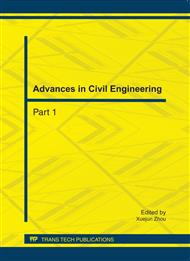p.3206
p.3214
p.3218
p.3222
p.3227
p.3234
p.3239
p.3245
p.3250
Algorithm and Program for Simulating Heat Transfer in Cavities of Structural Members under Fire Conditions
Abstract:
In this paper, an algorithm based on the network method suggested by Oppenheim for calculating the radiative heat flow in a cavity of structural members, say hollow core concrete slabs, exposed to fires is presented. It is assumed that the pressure in a cavity keeps atmospheric pressure through the whole cause of a fire, and the lost heat from the air due to expansion and immediate moving away from a cavity is neglected. The heat in a cavity is transfer via both heat conduction in air and thermal radiation among boundaries, and special regard is paid to modeling heat transfer by radiation. The effective radiative heat flow system of equations is derived and expressed in matrix form. The system of equations features a symmetric coefficient matrix, which can be stored in a one dimensional array, and can be solved using LDLT factorization. Node radiative thermal loads are calculated from effective radiative heat flows at edges of elements located on internal cavities. The nonlinear finite element program TFIELD written by first author has employed the new algorithm. Temperature distribution in two structural members with cavities are calculated using TFIELD, and numerical results demonstrate that the new algorithm is very effective and is useful for further study of structural behavior of structural members under fire conditions.
Info:
Periodical:
Pages:
3227-3233
Citation:
Online since:
September 2011
Authors:
Price:
Сopyright:
© 2011 Trans Tech Publications Ltd. All Rights Reserved
Share:
Citation:


